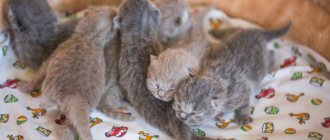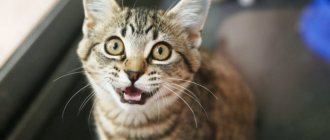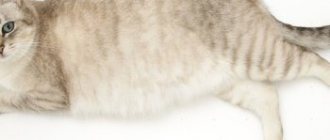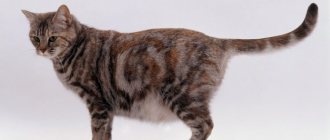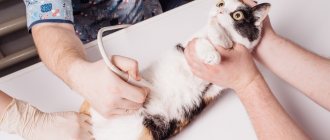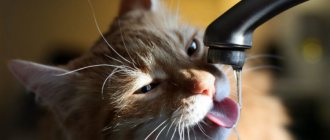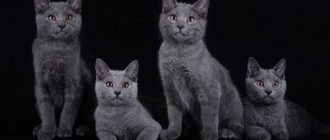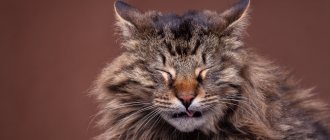- Pets
- >>
- Cat breeds
* Here is a photo of a typical representative of the Angora cat breed . You can send us photos of your animals by email, and we will post them on the website. Don't forget to send your pet's name.
Other breed names:
Turkish Angora
Video
* We invite you to watch a video about the Angora cat . In fact, in front of you is a playlist in which you can select and watch any of 20 videos about a given cat breed by simply clicking on the button in the upper right corner of the window. In addition, the material contains quite a lot of photos. By looking at them you can find out what an Angora cat looks like.
In this article:
|
Rate the material!
[Total votes: 1 Average: 5]
The Angora cat or Turkish Angora is a pet bred by breeders and officially included in felinological works in the mid-20th century. Representatives of this breed are particularly elegant, neat and flexible. Animals are very curious and train well. Thanks to these qualities, Angora cats are very popular among cat lovers all over the world.
Breeding Turkish Angora
The main condition for breeding this breed is the ideal state of health and appearance of the individual. You must have all the necessary documents and pedigree for your pet. Only when you have it in hand can you start looking for a mating partner.
How to choose a kitten
You should choose a kitten with special care and caution. There are significant risks of getting an outbred animal that will only partially look like the Angora breed.
Unscrupulous breeders offer white, non-purebred Persians, passing them off as the ones they are looking for. You should seek the help of a specialist in the field of felinology, who can accurately distinguish purebred individuals from half-breeds. To make the right choice, there are several rules that are important to know before visiting the nursery:
- You cannot purchase a kitten under 12 weeks old. Such kittens are still weak and must be breastfed naturally. Moving to a new place will be a serious challenge for them.
- Be sure to have your kitten examined. It should not have an unpleasant odor, the coat should be clean, and there should be no discharge on the eyes or ears.
- The belly must be soft, otherwise there is a possibility that the animal is infected with parasites.
- Together with the baby, the owner receives his veterinary documents, pedigree, registered in the official breeders club.
The passport contains notes about vaccinations that were carried out at 9 and 11 weeks. If this condition is violated, you should not purchase such kittens. Many breeders sign a sales contract only on mutual conditions that the new owner will subsequently sterilize his pet.
How much does a Turkish Angora cost?
The average cost of a purebred kitten, depending on its class, can cost from 5,000 to 30,000 rubles. There are quite a lot of professional nurseries and breeders in our country; finding a suitable animal will not be difficult. After the purchase, the question arises of what to name a Turkish Angora kitten. The table below shows popular names, among which it is easy to choose the right one.
Table of popular names for Turkish Angora.
Pregnancy and mating
Mating can be carried out only after her body becomes ready for this. Typically, breeders or catteries use cats after the third or even fourth mating. That is, after about the first year of life. This condition also applies to males. Pregnancy in an animal lasts on average 65 days. Usually the birth itself is not accompanied by difficulties, so if there are no special indications, there is no point in taking the “mommy” to the veterinary clinic.
Interesting read: everything about the Balinese breed.
History of the origin of Angora cats
The history of the origin of the Angora cat begins in the ancient Turkish city, on the site of which Ankara now proudly stands. It was here that angoras became interested in the emperors, who “invited” these wonderful pets to their palaces. Cats enjoyed special privileges among the Turkish nobility. Angora pets did not know what refusal was and walked proudly even in the mosque. It is quite possible that modern animals simply cannot forget the status of their ancestors and therefore behave at least like a king.
Angora cats were called Sultan cats and for a long time were found only in Turkey - the authorities strictly prohibited the export of pets outside the state. These pets were presented as gifts only to the most status guests of Turkey. And only thanks to them the animals managed to get to Europe and Russia. The first mentions of Angora beauties on this land date back to the 16th century. Later, during the Russian-Turkish wars, Angoras appeared in Russia mainly in the form of victory trophies.
Interesting fact: Cats were sent to America on purpose. They were transported there by ship. Thus, Marie Antoinette saved her beloved pets from the French Revolution.
The widespread use of Turkish Angoras almost resulted in a sad outcome for the breed. The fact is that in 1887, British felinologists created a new decree according to which all long-haired cats were considered Persian. Because of this, a real breeding boom occurred, active crossing of Angoras with Persians began, which led to the destruction of valuable gene pools of both breeds.
The alarm was declared only when, in terms of their numbers, Angora cats were practically classified as “Endangered.” A large program for the conservation of the breed and its development was launched by felinologists in Turkey. The provision turned out to be quite effective and is still in effect today.
History of the origin of the breed
The Angora cat is the national pride of Turkey, because the breed first appeared in this country around the 16th century. The name was invented in honor of the former capital - the city of Ankara. The ancestors of four-legged cats were most likely Persian cats. Representatives of the cat family were brought to European countries from Turkey, mainly as gifts, which suggests that the Turkish Angora is not considered a purely indigenous breed. In Europe, animals immediately became favorites of royal and imperial palaces.
Angora kittens were considered prestigious pets, so only a select few could enjoy their presence in their homes. These graceful individuals with lush fur coats and almond-shaped eyes were received with honor in the Russian Empire. The German zoologist Bram described the breed in 1860 as the most beautiful of all existing ones. Soon, long-haired oriental beauties became popular and in demand all over the world, because almost all other members of the cat family were short-haired. In 1973 and 1978, the CFA registered the Angora as a breed of white and colored cats.
Angora cat - description of the breed
From the history of the origin of Angora cats it becomes clear that these animals have royal roots. This guess is confirmed by the appearance and character of the graceful Angoras. Silky coat of varying lengths (medium and long), expressive eyes, fluffy tail and boundless elegance - this is how you can describe the pets of this breed.
The body of the angora is proportional and neat. Adult animals reach medium (very rarely large) size. Due to their physique, cats move very plastically, jump easily and walk smoothly.
Features of representatives of this breed also include:
- The ears are set high and pointed at the ends and are large in size. They stand out clearly against the background of the pet’s neat small muzzle;
- Almond-shaped eyes are blue, green or yellow. A common deviation from the norm is the different colors of the eyes, due to which the animals acquire an even more mysterious and attractive appearance;
- Silky, thick, iridescent coat. The coat remains in this condition until the pets are very old. These animals belong to the “Semi-longhair” category. The soft and smooth fur of cats makes you want to pet them endlessly. A special feature of the wool is its different lengths. If the fur on the neck is quite short, then on the tail it is as long as possible, due to which the “Ostrich feather” effect is achieved.
As adults, Turkish Angoras reach a weight of 4-6 kg and 3-5 kg (males and cats, respectively). The height at the withers of such animals is 25-30 cm. The average life expectancy is 15 years. However, with proper care this figure increases to 20.
Turkish Angora - description of the breed
The Turkish Angora is not a very big cat. However, it looks much larger than its actual size thanks to its long fur, slender limbs and long fluffy tail. According to breed standards, the height of the Turkish Angora at the withers is approximately 35 cm. At the same time, the male weighs no more than 5 kg, and the female weighs no more than 3 kg.
The cat's physique is fit, slender, elongated. A medium-sized head in the shape of a wedge or triangle is set on a graceful and sophisticated neck. The cat's eyes are quite large, slightly slanted, one might even say almond-shaped, like a real oriental beauty. The iris of the eyes comes in a variety of colors, and it is not uncommon for the same animal to have eyes of different colors. The ears are also large, set high, pointed and with small tufts at the tips.
The Turkish Angora's coat is long, very soft and silky, and has virtually no undercoat. It is most elongated in the neck, chest, hind legs, and between the toes. On the back of the cat there is a so-called cloak, consisting of long guard hairs. It is worth noting that all guard hairs have a hollow structure, which undoubtedly helps the animal feel quite comfortable in both hot and cool conditions. The color of the coat of these cats is quite varied, but the most valuable is the pure white color.
The tail of this cat is worthy of a separate description. In its length it can compete with the length of the entire body of a cat, and in appearance it resembles a peacock feather.
Popular colors of Angora cats
The classic and most popular color of Angora cats is pure white. It is the pets of this color that are most popular in Turkey and are considered true Angoras. Subsequently, after numerous selections, felinologists managed to develop a huge variety of coat colors.
The most popular among them are:
- Black is a charcoal dark, monochromatic shade. Paw pads and skin are black or dark brown;
- Red – deep brownish-red color without darkened or lightened areas. Only the paw pads and nose differ from the main color, which are painted brick;
- Blue is a monochromatic light color that shimmers with light shades. The color of the pads and coat are almost identical;
- Cream – soft peach color, the same throughout the body. Paw pads are pink;
- Black smoke is a combination of white undercoat and deep black fur. The multi-tone color is noticeable mainly when the cat moves. Paw pads are blue;
- Marble tabby is a patterned color, with a pronounced headband and clear patterns on the body. The lines are located mainly on the back - smoothly descending from the head. All patterns are parallel to each other. Small stains on the sides are surrounded by a large circle. In the neck area there are clear lines reminiscent of a necklace. The limbs are ringed with small-diameter bracelets;
- The brindle tabby is a patterned color, the characteristic feature of which is the presence of a continuous line running from the eyes to the back of the head. The body of the animal is outlined by small stripes, reminiscent of the color of a tiger. The limbs are also edged;
- Silver tabby is a silvery, non-solid color. Black patterns are clearly visible;
- Cream tabby is a monochromatic light shade with small patterns that are 1-2 shades darker than the main color;
- Bi-color - any shade in combination with basic white (black and white, blue and white, cream and white, etc.).
Despite the fact that only white Angoras are recognized in Turkey, the pet can be any color. The only exceptions are chocolate and lilac shades, which are uncharacteristic for this animal.
Character and habits of Angora cats
Angora cats have pronounced “royal” manners. These animals are extremely elegant and discreet. They get along well with people, quickly become attached to their owners and serve them faithfully until the end of their days. Angoras are very inquisitive and intelligent. Because of these qualities, these cats are often compared to dogs. Angora pets are able to learn several commands. Particularly patient owners were able to train the animals to fetch objects in their teeth and close/open doors. It is quite difficult to train such cats, but it is possible. Angoras are big water lovers. Not only are they not afraid of it, but they also have a positive attitude towards the idea of “swimming in the bathtub.”
No less interesting character traits of pets are:
- Goodwill. Cats are kind to people and other pets. They are not afraid of new acquaintances, as they always feel like leaders;
- Hunting habits. Angoras can give their owner a trophy in the form of a mouse or lizard. The main thing is not to leave the parrot (if you have one) unattended;
- Patience. Despite their royalty and leadership, Angora cats are quite patient. This is especially noticeable when they communicate with children;
- Persistence. Turkish animals do not tolerate their requests being ignored. They will meow continuously until the owner fulfills their demands;
- Curiosity. Pets are very inquisitive and study with genuine interest new toys purchased by the owner;
- Sensitivity. Angoras sense a person’s mood and his attitude towards himself. They do not like loneliness and have difficulty withstanding their owner’s long trips;
- Playfulness. Representatives of this breed are quite active and mobile. At the same time, playfulness largely depends on the current mood.
Angora cats are suitable for those people who really love animals and are willing to devote enough of their time to them. Those who are constantly at work or often go on business trips should not purchase them. The pet will be very sad when alone. If a long-term absence from home cannot be avoided, you should buy a good angora friend with whom the cat can spend its time.
Character of the Turkish Angora
The Turkish cat is distinguished by restraint, high intelligence, and activity. This breed is also affectionate and gets along well with people, children, and other animals living in the apartment. Shyness is not typical for them, they love to spend their time next to their owner. When guests arrive, they may hide in a secluded place for a while, but then they will still go and get acquainted with them.
Angora talkativeness is rare. These cats are attentive and observant. They easily remember how the doors of cabinets, refrigerators and other movements of the owner open, which they then repeat to the best of their physical abilities.
If the owner hid his favorite toy from her, the cat will certainly find it and make every effort to get it back. They are good at capturing the intonations in the voice, the change in mood of a person, especially their loved one.
Turkish breed cat.
Interesting facts about Angora cats
Angora cats are unique animals, interesting for their appearance, history of origin and habits. They never cease to amaze their owners throughout their lives.
At the same time, there are several interesting facts that few people know and which all lovers of this breed should know about.
Here are some of them:
- The Turks officially cemented their love for Angoras in 2015. It was at this time that the first coins with the image of this animal were issued in Turkey. Other countries also issued collectible coins with Angora cats. Such money is quite popular among collectors;
- Many animal lovers choose Angora cats because of their amazing eyes of different colors. Many people associate this demand with an ancient Turkish legend. According to it, the father of all Turks promised to give all his power to the person who was bitten by a white angora with multi-colored eyes;
- A distinctive feature of Angora cats is the ability to meow to themselves. Animals often “talk” with their mouths closed;
- All Angoras are very clean. They keep their snow-white fur in perfect condition under any circumstances. There is even a legend that Turkish rulers used these animals to wipe their hands on them after meals. The pets quickly washed off the dirt and regained their whiteness on their own;
- The Angora cat often acts as an actor. Thus, it was the representative of this breed who starred in the cartoon “Aristocrats” and the film “The Raven”.
Such pets will never make their owner bored and will always help him cope with a bad mood. Angora cats are good psychologists. Thanks to their excellent sense of smell, they quickly understand the condition of their owner. If he is sad, the pet will sit on his lap and purr. If the owner is in a good mood, the animal will support him with its playfulness.
How to increase the lifespan of a Turkish Angora
In order for a domestic cat to please its owner with excellent health and well-groomed appearance, as well as physical activity and playfulness for as long as possible, you need to follow a number of basic rules for keeping a Turkish Angora.
Providing an animal with a healthy diet is not too difficult, but it is very important to correctly assess the age characteristics of the Angora cat, its activity and weight, as well as its taste preferences. Cats are carnivores, so they need a sufficient amount of complete animal protein to enter their body.
For feeding, exclusively fresh food at room temperature or ready-made special dry and wet rations are used. Dishes for food and water must be clean, so they are washed regularly with hot water. The use of dry rations in the nutritional scheme presupposes the mandatory availability of clean drinking water in a volume sufficient for the animal around the clock. It is advisable to give preference to high-quality dry food for dietary purposes, which are produced by many well-established manufacturers.
Annual vaccination of a domestic cat is also mandatory, even in the absence of regular walking outside . Quite often, causative agents of diseases that are dangerous for the Turkish Angora and cause death are brought in by cat owners and household members on shoes or street clothes. It is necessary to regularly examine your pet for tumors and abscesses, as well as wound surfaces and ectoparasites.
Important! Antihelminthic measures should be carried out every six months, regardless of the presence of external signs of parasites.
An Angora cat in the house is a real “child”, extremely curious, in need of attention and care. All circumstances that could lead to health problems for a pet should be kept to a minimum. It is imperative to remove poisonous indoor plants and household chemicals out of reach of the animal, as well as secure breakable or too heavy interior items.
It should be noted that timely sterilization of cats and castration of cats that are not used for breeding does not have a significant impact on the average life expectancy of a pet. However, it is precisely such an event that can significantly reduce the risk of the Turkish Angora developing infectious diseases as a result of contact with infected animals.
Providing the Angora cat with proper regular care is of no small importance for preserving life and health . It is imperative to carry out hygienic measures to care for the eyes and ears, coat, as well as the teeth and claws of your pet. Developing a familiar and correct system for keeping an Angora cat allows you to preserve the life and excellent health of your pet for many years.
Return to content
Pros and cons of Angora cats
Graceful, intelligent, caring Angora cat. Could she have any shortcomings? Unfortunately yes. But I still want to start with the advantages of these animals.
The main advantages of angoras are:
- Cute appearance;
- Pleasant wool texture;
- Positive and calm character;
- High (for animals) mental abilities;
- Tendency to train;
- Cleanliness;
- Devotion.
Turkish Angoras do everything for their owner. They quietly wait for him at the door during working hours and do not take a step away from him after returning home. These cats are aristocratic and simple at the same time. They will not use a dirty tray and will stubbornly meow around it until the owner changes the litter. At the same time, the animals are not too demanding in care.
As for the disadvantages, the main one is increased molting of animals. When getting an Angora, be prepared for the wool to fill the entire house. This is due to the thickness and length of the animals’ fur. Hairs often fall out and are replaced by new ones. If there are people with allergies in the house, then buying an Angora pet is definitely not the best idea.
No less important disadvantages also include:
- Stubbornness and capriciousness;
- Fearfulness and jealousy;
- Increased activity (the pet may want to play even in the dead of night);
- High appetite.
At the same time, those who had the opportunity to be the owner of an Angora cat confirmed the insignificance of all these disadvantages. The animal's shortcomings are fully offset by its advantages. Often, negative behavioral traits can be eliminated with the help of proper education. But such “adjustment” of a pet is possible only at an early age (mainly up to six months).
Angora kittens
Having decided to get a furry pet, it is important to remember that under the guise of a purebred Angora, unscrupulous breeders are increasingly selling outbred individuals or kittens of the breed of short-haired Turkish cats, Van, Anatolian or Angora chinchillas. Experts strongly recommend buying Angora kittens exclusively from nurseries that have a good reputation - this way you will be sure that you have purchased a purebred animal.
The Angora cat is an excellent choice for those who want to have a pet for the first time. It is important to know that the optimal age for a kitten to be weaned from its mother is 8-9 weeks: by this time the baby will have already developed immunity and will be able to fight diseases on its own. It is worth noting that the cost of a purebred individual also depends on the size of the litter: a female gives birth to only 3-4 babies at a time, so often in order to buy a pet of this breed, you need to sign up for a waiting list.
Where can I buy
Thanks to ongoing selection work, the shades of fur color of Angora cats have become significantly larger, so it can be very difficult for a non-professional to independently determine the quality of the animal’s breed . For this reason, it is recommended to buy Angoras exclusively in specialized nurseries, because for a very high price you can get a mixed breed or an outbred kitten from unscrupulous breeders.
In Moscow there are several organizations involved in breeding cats of different selections and colors. You can choose a purebred kitten in one of the following nurseries:
- Anamur is a nursery whose activities are aimed at breeding purebred show Angoras;
- Alisa-best is an organization where you can find Angora kittens of different colors;
- AKKEDI is one of the best nurseries, having diplomas and awards in various categories. Specialists here breed white and colored Angoras.
- Pumice for heels
- How to change the file format
- How to make a smokehouse with your own hands
How to choose a kitten
The Angora cat is an excellent choice for a loving, gentle, sensitive and attentive person. Those who have decided to buy a four-legged friend need to do everything sequentially:
- Decide what gender the kitty will be. After this, you should study the characteristics of the breed, analyze whether you can care for your beauty or handsome man.
- When a nursery is found, it is recommended to consult with specialists regarding the care of the selected animal, familiarize yourself with the availability of documents for it, a veterinary passport, which indicates all vaccinations in accordance with age.
- In the nursery, find out more about the health and character of the cat’s parents, find out whether previous litters had problems.
- Examination of an Angora kitten is one of the most important moments. The baby must meet the breed standards, look healthy and cheerful, have a smooth shiny silky coat, clear eyes. The animal's belly should not be too large - bloating may indicate the presence of worms. Inflammation in the anus means that the baby is suffering from digestive problems. It is advisable to do a test for deafness: jingle a toy away from the kitten - an animal that has no hearing problems will definitely turn around. It happens that Angoras have such an ailment as a non-corrected or broken tail. You can rule out the presence of a defect by feeling the end of the tail - if everything is normal, the vertebrae will be located exactly in one line.
Breeding Angora cats
Intentional breeding of Angora cats began only in the 20s of the 20th century. Such measures were necessary in order to prevent the breed from becoming extinct. For 40 years, Turkish felinologists fought to preserve this individual and actively bred white fluffy cats. All this time, a strict ban was imposed on the export of these animals.
Interesting fact: To cross the border with an Angora cat, it was necessary to obtain special permission. It was also issued to two women who were wives of US military officials. It was they who managed to take the unique breed overseas, where the breeding of the Angora cat began, not to preserve the population, but to spread the breed throughout the world. This happened in the 60s of the last century.
Already 10 years after the start of Angora breeding (in 1973), these animals were identified by felinologists as a separate breed. In 1979, the Angora cat was recognized by the International Cat Association, and 15 years later, European felinologists officially expanded the number of shades allowed for this breed.
Today, Angora breeding is carried out by both professional felinologists (breeders) and amateurs (breeders/breeders). The former are distinguished by a more serious approach to this activity. They breed only breeding animals, carefully selecting partners based on numerous criteria (character, color, pedigree). Breeders sell animals directly from shelters, where the buyer can evaluate the living conditions of the pet, its characteristics and features of the appearance and behavior of the parents.
Breeders approach breeding Angoras from the material side. For them, what is more important is not the purity of the breed, but the fastest possible profit. As a rule, breeders sell the offspring of their pets “from hand” through message boards and social networks.
If you want to buy a breeding cat, be prepared to pay a lot of money. Such animals cannot be cheap, since entire associations are involved in the development of their population. A distinctive feature of breeding Angoras is the presence of Turkish roots in the pedigree.
Caring for Angora cats
Wool is the main drawback of Angora cats. It is in its processing that the main difficulties of caring for an animal lie. It is necessary to comb your pet (during shedding) every day. In normal times, this procedure should be carried out as needed (at least once a week).
In addition, to maintain the cleanliness and structure of the coat, the animal should be washed periodically. This can only be done using specialized cat shampoos. Conventional products (which people use) can only spoil the structural features of the hairs and harm the pet’s skin. Thanks to Angoras' love for water, their bathing is as comfortable and even interesting as possible. It's not just the animal's fur that needs to be taken care of.
Here are some recommendations for caring for representatives of this breed:
- Brush your teeth regularly (1-3 times a week). For this procedure, you should use only special formulations, which can be purchased at a zoological store;
- Check your cat's eyes and ears daily. Dirt should be removed with a cotton swab or cotton cloth. If the discharge is too profuse (which has not been observed before), you need to contact a veterinarian;
- Get a scratching post and don't forget to trim your nails regularly. This procedure should be carried out as necessary using special tweezers;
- Keep an eye on the animal's litter box. Contaminated litter not only repels the animal, but is also a source of bacteria that can adversely affect the health of the pet.
There are no supernatural rules for caring for an Angora cat. These animals do not require special treatment. They do an excellent job of cleaning wool from dirt on their own. And thanks to the presence of undercoat, combing the pet does not cause much trouble to its owner.
Rules of care
Caring for Turkish Angora cats is simple:
- Combing. Animals are brushed twice a week, and during the molting period the frequency of brushing reaches several times a day.
- Bathing. A white Angora cat needs bathing no more than once a month. Turkish Angora cats take water treatments with great pleasure. This is one of the breeds that is not afraid of water. The fluffy Turkish cat happily swims in warm water and is able to teach this to her babies. During bathing, she is washed with a special shampoo, which is intended for long-haired cats.
- Care for nails, eyes, teeth and ears. Nails are trimmed as they grow, using a special nail clipper. Dental care involves brushing with a special brush several times a week. Mucous discharge from the eye is removed with a cotton swab. The ears are cleaned as they become dirty, using a cotton swab moistened with hydrogen peroxide or other antiseptic agents.
Diet of Angora cats
Up to 1-2 months, Angora cat cubs feed primarily on mother's milk. Feeding is introduced only when the animal becomes independent. The first food is dry food.
Transfer to it should be carried out directly in the nursery, where specialists can quickly assess the animal’s reaction to one or another component and replace it if necessary. As for older cats, they are not picky about food.
The diet of animals can be of two types:
- Artificial. Pets can only eat formula and canned food without harm to their health. The main thing is to give preference to only premium-level feed. Otherwise, the cat may simply refuse such feeding or may not be able to receive all the microelements necessary for good health;
- Natural. Angoras were not bred artificially. Hundreds of years ago they ate the same food as humans. Therefore, even today the animal tolerates natural feeding very well. If you decide to feed your pet the right foods, then keep in mind that his daily diet must contain at least 30% protein, 60 different nutrients, and easily digestible fats.
Angora kittens eat 4-5 times a day. For older pets, this frequency is reduced to 2-3 times a day. The animal should be fed at strictly prescribed times. After eating, it is better not to disturb your pet, but to give him the opportunity to digest the nutrients he receives. Such strict rules are associated with the tender stomach of Angoras.
The angora's diet must be periodically changed and supplemented. Boiled beef, chicken, and turkey can serve as an additional treat. You can feed your pet vegetables (in any form), eggs, cereals, potatoes and cottage cheese. But giving cream, pork and raw milk to your Angora cat is not recommended. Such products can cause stomach irritation, which can cause the occurrence/development of diseases.
Diseases and health problems
Angora cats are quite gentle and receptive animals. Despite active attempts by breeders to improve their health, not all ailments can be eliminated. Angoras are characterized by both congenital and acquired diseases.
The most common among them are:
- Deafness. This disease is especially common among white animals. In recent years, thanks to the efforts of felinologists, the percentage of congenital deafness has noticeably decreased;
- Diseases of the musculoskeletal system. The main cause of this type of disease is a lack of nutrients in the diet and poor heredity. Dysplasia and limb dysfunction are the most common;
- Nervous system disorders. The most common disease of the central nervous system is ataxia. It may occur due to damage to the spinal cord or peripheral nerves. The disease affects the motor functions of the body, without in any way affecting the mental abilities of the animal or its life expectancy;
- Diseases of the cardiovascular system. Heart pathology is most often transmitted from parents. Usually it proceeds violently and almost always ends in a shortening of life;
- Urolithiasis. The formation of stones in the urinary tract provokes the disease urolithiasis. This disease is most common among obese animals.
Chronic and congenital diseases must be included in the pet’s medical passport. Acquired diseases are indicated by such signs as: general fatigue, loss of appetite, fever, vomiting, diarrhea, shortness of breath, purulent discharge from the ears/nose. If such symptoms occur, it is recommended to take your animal to the veterinarian. Correctly and timely prescribed therapy will help not only cure the cat, but also prolong its life.
The prevention of any disease is proper nutrition, timely vaccination and regular visits to the veterinarian. A specialist must not only administer seasonal vaccinations, but also conduct tests that can help identify serious illnesses in the early stages.
